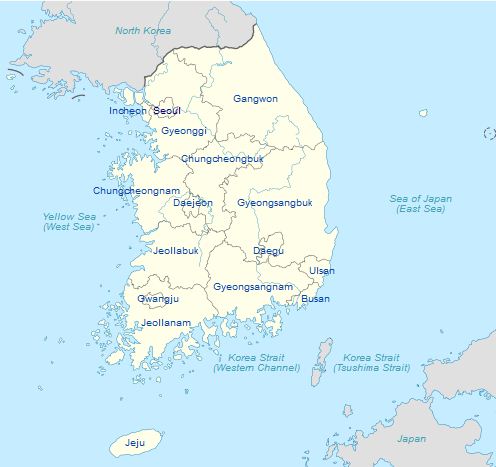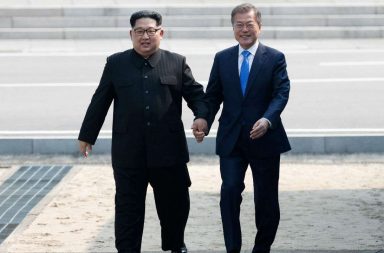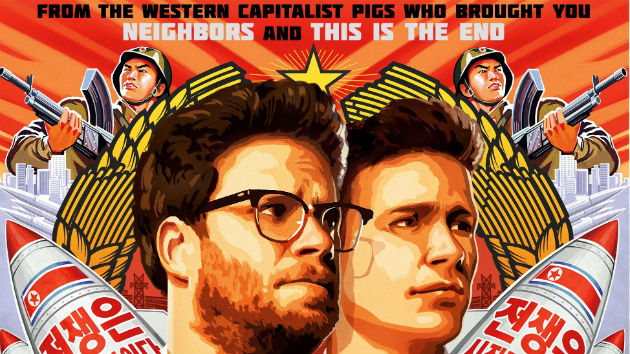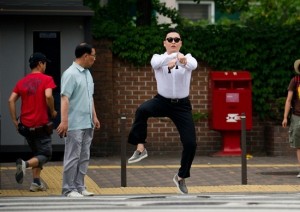 Thanks to Psy, you’d be hard-pressed to find a K-pop fan (or really, any human being with a pulse) who hasn’t heard the word “Gangnam” — and thanks to probing done by journalists interested in a bit more than just gratuitous ass shots and horse dances, a good number of non-Korean K-pop fans have now come to know that Gangnam is, in fact, a region in Seoul well-known for its overwhelmingly nouveau-riche air and classed-up selection of trendy coffeehouses, clubs, and designer brand-carrying shops. But did you know that just a scant few decades ago, the area that we know today as Gangnam was nothing more than a long stretch of sparsely populated rice paddies? No? Well, good — because that’s where we here at Seoulbeats come in!
Thanks to Psy, you’d be hard-pressed to find a K-pop fan (or really, any human being with a pulse) who hasn’t heard the word “Gangnam” — and thanks to probing done by journalists interested in a bit more than just gratuitous ass shots and horse dances, a good number of non-Korean K-pop fans have now come to know that Gangnam is, in fact, a region in Seoul well-known for its overwhelmingly nouveau-riche air and classed-up selection of trendy coffeehouses, clubs, and designer brand-carrying shops. But did you know that just a scant few decades ago, the area that we know today as Gangnam was nothing more than a long stretch of sparsely populated rice paddies? No? Well, good — because that’s where we here at Seoulbeats come in!
Today’s lesson in Korean culture is more of a lesson in history and geography. If you’ve never been to South Korea, we hope that this will provide a more-or-less comprehensive guide to understanding the South Korean peninsula, particularly its dynamic capital city of Seoul — and you don’t even have to buy a plane ticket! Seoul is quickly becoming one of the largest and most visited metropolises in Asia, and whether you’ve been there or not, there’s always something new to discover.
The Korean peninsula has a long history that, according to legend, began about 5,000 years ago with the mythical father of the Korean people, Tan-gun. After playing host to a number of pre-modern kingdoms (many of which have lent themselves to the creation of historical dramas), the peninsula was finally largely united under the Goryeo dynasty and later the Joseon dynasty. The Joseon dynasty would be Korea’s last, as the peninsula was colonized by Meiji Japan in 1910 and was liberated only to be divided upon Japan’s defeat in World War II. The decision to divide Korea in two was actually an administrative decision more than anything else; after the Soviet Union entered World War II and landed on the Korean peninsula, it was decided to divide the colony along the 38th parallel to both facilitate Japanese surrender to the United States and the Soviet Union and to create post-war zones of occupation. The division was, of course, to become permanent; the Republic of Korea (South Korea) was proclaimed in 1948, and the Democratic People’s Republic of Korea (North Korea) was founded shortly after. After a bloody three-year war, South Korea and North Korea have taken vastly different paths and evolved in disparate ways.
So what does the South Korean portion of the peninsula look like today? South Korea is divided into a number of administrative regions/provinces, called do (pronounced “dough” — not to be confused with the same do that also indicates an island!). These provinces are as follows: Gyeonggi-do (northeast), Gangwon-do (northwest), North Chungcheong-do (center), South Chungcheong-do (center-west), North Gyeongsang-do (center-east), South Gyeongsang-do (southeast), North Jeolla-do (center-southwest), South Jeolla-do (southwest), and Jeju-do (an island off the southwest coast). In picture form, it looks like this:
Regionalism plays quite a large role in South Korea, and discrimination and stereotyping of people from regions outside of Gyeonggi-do (the most populous province, home to the Seoul metropolitan area) is severe and problematic. This is visible in a ton of Korean dramas and movies; those who have seen the blockbuster Sunny will know that Na-mi is recognized almost immediately as an outsider by her thick Jeolla-do accent — which instantly earns her Su-ji’s scorn, largely because Su-ji’s hated stepmother is from the same area. The title character in the drama King of Baking, Kim Takgu is picked out as a Busan boy (Busan is the capital of South Gyeongsang-do) from his similarly strong accent. But the problems inherent in South Korea’s regionalism are most definitely a post in and of themselves — and indeed, one for another time.
As mentioned, Gyeonggi-do remains South Korea’s most prosperous province — and this is due largely (or entirely) to the fact that the capital city of Seoul and its surrounding regions are located here. For much of Seoul’s 2000-year history, it was a capital city; in fact, it served as the capital city of the Joseon dynasty, and its location below the 38th parallel was part of the United States’ decision to place the peninsula’s southern half under their jurisdiction. However, Seoul did not escape from the Korean War unscathed; much like the rest of the country, Seoul was reduced to a city of rubble and ruin. South Korea’s rise from the ashes is remarkable in and of itself, but nowhere is the country’s progress best seen quite like it is in Seoul. Seoul has become emblematic of South Korea’s commitment to economic growth, to technological advancement, and to globalization.
So what’s Seoul like? If you’ve seen any drama situated in Seoul (and there are many), you’ll probably have some ideas about what you can find in Seoul, but dramas don’t often capture the paradoxical nature of the city itself. Seoul is a blend of old and new, of ancient and modern, of Korean and international. Parts of the city are cosmopolitan and new-age; other corners offer glimpses of a more traditional Korea.
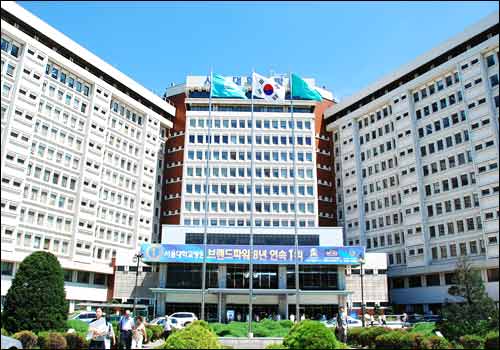 Seoul is situated on the Han River, which cuts the city neatly in half. The word “Gangnam,” in fact, translates literally to “south of the river” and can be used to refer not only to the administrative district of Gangnam-gu, but also any area located south of the Han River. Conversely, the northern half of the city is referred to as “Gangbuk,” which means “north of the river” (broken down, “gang” = river, “nam” = south, “buk” = north). While “Gangnam” has come to be synonymous with the flashy glitz and glamour portrayed in Psy’s hit song (and it is true that today, it is the wealthier of the two), Gangbuk used to be the hub of most activity in Seoul; a number of prominent universities, including Yonsei University, Korea University, and Ewha Woman’s University (the largest women’s university in the world) are located in Gangbuk, as is City Hall and a number of important government offices.
Seoul is situated on the Han River, which cuts the city neatly in half. The word “Gangnam,” in fact, translates literally to “south of the river” and can be used to refer not only to the administrative district of Gangnam-gu, but also any area located south of the Han River. Conversely, the northern half of the city is referred to as “Gangbuk,” which means “north of the river” (broken down, “gang” = river, “nam” = south, “buk” = north). While “Gangnam” has come to be synonymous with the flashy glitz and glamour portrayed in Psy’s hit song (and it is true that today, it is the wealthier of the two), Gangbuk used to be the hub of most activity in Seoul; a number of prominent universities, including Yonsei University, Korea University, and Ewha Woman’s University (the largest women’s university in the world) are located in Gangbuk, as is City Hall and a number of important government offices.
It was only when a government campaign to better develop Gangnam (and to clean up what really was not a very nice area) was put into action that Gangnam began to turn into the ritzy and fast-paced city center that we see today. In an effort to move intelligent people out of Gangbuk and into Gangnam, Seoul National University, which was and is South Korea’s largest and most respected public university, was relocated from Gangbuk to Gangnam. The University’s move prompted not only the relocation of Korean academics from north to south, but also a construction boom that filled Gangnam’s empty fields with burgeoning industry — a trend that has continued today. Gangnam gradually gained a reputation as a financial district as more and more companies began to build themselves up there, which spurred the construction of more and grander apartments. Some of Seoul’s most expensive housing is located south of the river — if you ever meet anyone (either literally or through your TV screen) who is from Gangnam, Seocho, Apgujeong, Sinsa, or Jamsil (among others), it’s probably safe to assume that any designer brands they may be wearing/carrying aren’t knockoffs. Fun fact about Apgujeong: it is referred to as Seoul’s “beauty belt,” for over 400 plastic surgery clinics are located there!
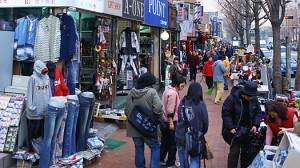 Which is not to say, of course, that Gangnam has gained at Gangbuk’s expense. Hardly! As mentioned, Gangbuk still holds the upper hand in terms of higher education, and the presence of so many universities has produced an extremely vibrant student culture. Yonsei University, Ewha Woman’s University, and Sogang University are all located within 10 minutes’ walk of each other, and the area where they are located (called Sinchon) has become one of the most colorful, cheap, and entertaining places to be in Seoul. One can’t walk five paces without happening on a fantastic restaurant, a great bar, or a cart filled with hearty and hot street food. One subway stop away from this hub of student life is Hongik University (more commonly referred to as HongDae), a university that specializes in the arts and has thus given rise to a fantastic number of art galleries, cafes, and music halls. HongDae is home to Seoul’s growing indie music scene, and you can easily find an open mic night or jam session if you know where to look. Oh, and the actual Coffee Prince cafe is located there — but sadly, this writer hasn’t heard very good things about it.
Which is not to say, of course, that Gangnam has gained at Gangbuk’s expense. Hardly! As mentioned, Gangbuk still holds the upper hand in terms of higher education, and the presence of so many universities has produced an extremely vibrant student culture. Yonsei University, Ewha Woman’s University, and Sogang University are all located within 10 minutes’ walk of each other, and the area where they are located (called Sinchon) has become one of the most colorful, cheap, and entertaining places to be in Seoul. One can’t walk five paces without happening on a fantastic restaurant, a great bar, or a cart filled with hearty and hot street food. One subway stop away from this hub of student life is Hongik University (more commonly referred to as HongDae), a university that specializes in the arts and has thus given rise to a fantastic number of art galleries, cafes, and music halls. HongDae is home to Seoul’s growing indie music scene, and you can easily find an open mic night or jam session if you know where to look. Oh, and the actual Coffee Prince cafe is located there — but sadly, this writer hasn’t heard very good things about it.
Gangbuk is also where you can find Itaewon, which was the subject of this infamous music video. Due to the presence of the American military base, which is essentially located there, Itaewon has become Seoul’s “global village,” if you will. Because most American soldiers speak only English, Itaewon has grown to cater to a largely non-Korean-speaking audience — and in the process, has attracted an increasingly diverse crowd of foreigners living in Seoul. Itaewon plays host to a large number of ethnic restaurants, some of which are noted to be the most authentic that you’ll find in Seoul, as well as a number of great bars and clubs that are staffed with English speakers. Itaewon certainly isn’t the place to go if you’re in the mood to try some traditional Korean grub, but if you want Taco Bell or ColdStone ice cream, then this is the place for you.
If, however, you decide after eating that chalupa that you’d like to wash it down with some traditional Korean tea, then you should head over to Insadong, which aims to provide a slice of Korea untouched by Western influence. Of course, this idea is rather loosely applied; there is, for example, a Starbucks in Insadong. But in a nod to Insadong’s traditional bend, no Western font is used to spell out the company’s name — or any company’s name, for that matter. Insadong may come off as a bit tacky and touristy, but watching traditional snack-makers spin a block of honey into 1,000 threads of sugary goodness (which are then wrapped around nuts and sugar — look up ggultarae to learn more about this killer dessert!) is highly entertaining.
There is so much more of Seoul to explore, and if you’d like us to elaborate more on some of what was mentioned here, do let us know! Questions or comments are welcome, and if you’ve been to Seoul, tell us about your favorite spots!
(Images: [1] [2] [3] [4], Seoul National University, Lee Ki-baek, A New History of Korea)
